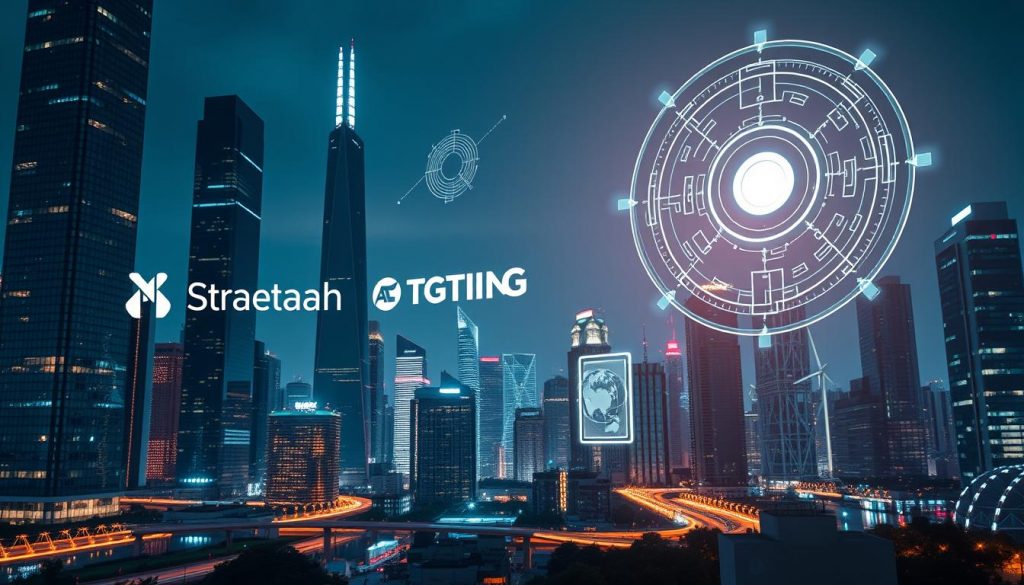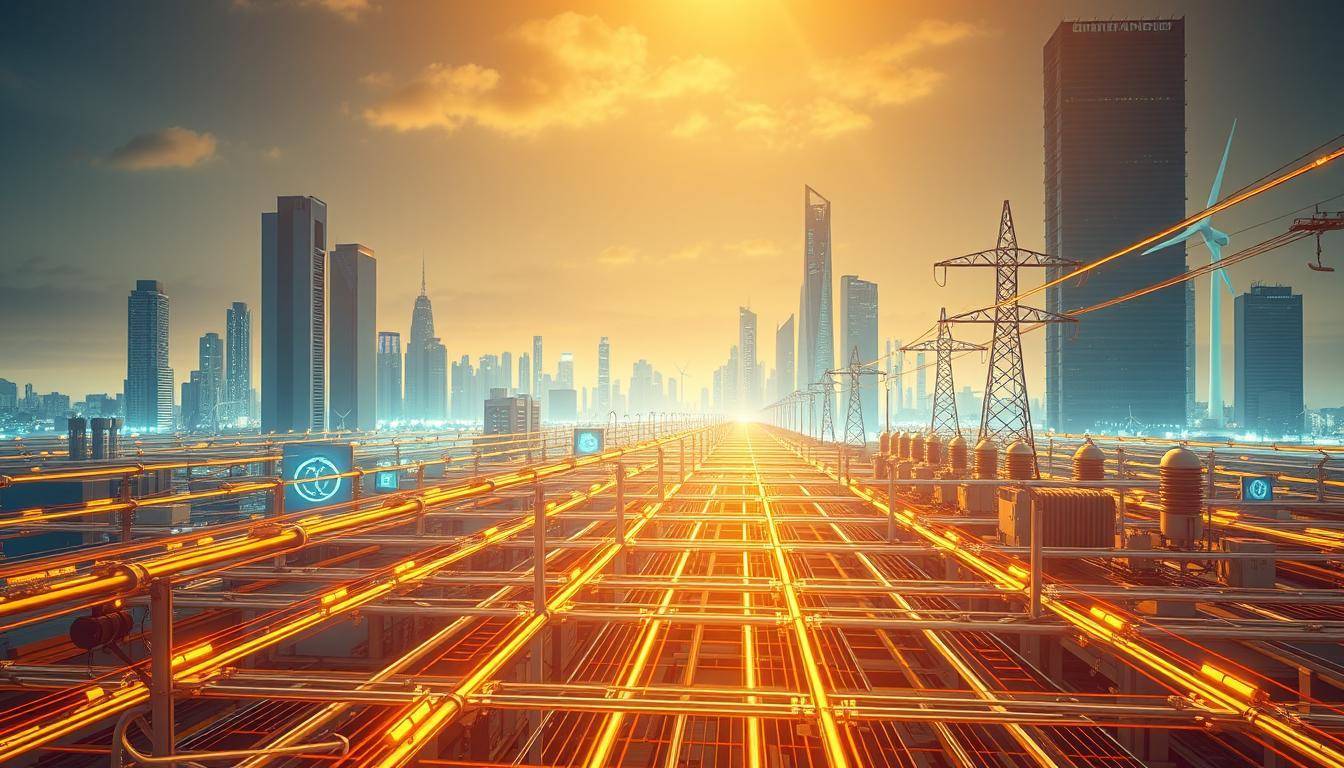AI Smart Grids: Future of Energy Efficiency 2025–2030. As the world moves toward decarbonisation and sustainable development, AI-optimised smart grids are emerging as a game-changer. These intelligent systems are revolutionising how energy is generated, distributed, and consumed. In the coming years, experts predict a rapid transformation in global energy infrastructure, mainly driven by AI in energy systems and smart grid technology.
But what exactly are AI-powered smart grids, and how will they shape the future? In this article, we’ll explore the benefits, challenges, and key trends driving smart grid innovation.
Key Takeaways
- AI is transforming the energy sector by making grids more efficient.
- Smart grid technology is key for renewable energy integration.
- AI-optimised energy management systems are more responsive.
- The future of energy efficiency depends on AI-optimised smart grids.
- Smart grids are essential for a sustainable energy future.
What Are AI-Optimised Smart Grids?
A smart grid is an electricity system that employs digital technology to oversee and manage the flow of energy efficiently. When enhanced with artificial intelligence (AI) and machine learning (ML), these grids become even more advanced, allowing for the prediction of energy demand, detection of faults, and real-time optimisation of energy distribution. For more information check out this industry report.
Key Elements of AI-Enhanced Smart Grids
- Advanced Metering Infrastructure (AMI) – Smart meters gather real-time information on energy consumption.
- Predictive Analytics – AI anticipates energy needs and modifies supply as needed.
- Decentralised Energy Resources (DERs) – Solar panels, wind turbines, and battery storage are integrated smoothly.
- Self-Healing Networks – AI identifies outages and automatically redirects power.
By leveraging these technologies, AI-driven smart grids reduce waste, lower costs, and facilitate the integration of renewable energy.
Why AI-Optimised Smart Grids Will Shape the Future (2025-2030)
1. Improved Energy Efficiency
Traditional power grids face challenges due to manual oversight and outdated infrastructure. however, AI-driven smart grids utilise advanced analytics to enhance energy distribution efficiency, that leads to a significant reduction in energy losses, potentially by up to 30%. Intelligent algorithms play a key role in dynamically adjusting power flow, aiming to minimise waste.
2. Seamless Renewable Energy Integration
As the world focuses more on solar and wind energy, it is becoming harder to balance energy supply and demand. Artificial intelligence in smart grids can help by forecasting weather patterns and optimising energy storage and distribution, that improves the reliability of clean energy.
3. Predictive Maintenance & Reduced Downtime
Rather than waiting for failures, AI-driven predictive maintenance identifies potential issues before they result in outages. This leads to:
- Fewer blackouts
- Lower repair costs
- Prolonged lifespan of equipment.
4. Demand Response Optimisation
During periods of high demand, electricity costs rise significantly. Intelligent grids that utilise AI encourage consumers to shift their usage to off-peak hours with dynamic pricing strategies, which reduces strain on the grid and lowers costs.
5. Cybersecurity & Fraud Detection
As grids transition to digital, the risk of cyber threats increases; however, with AI, this improves smart grid security by detecting anomalies and preventing unauthorised access, ensuring a resilient energy infrastructure.
Challenges Ahead (2025–2030)
As AI smart grids continue to evolve, several challenges must be addressed to ensure successful adoption.
One major concern is data privacy and cybersecurity, as smart grids rely heavily on real-time data from millions of endpoints, making them potential targets for cyberattacks. Additionally, upgrading existing infrastructure to support AI capabilities will require significant financial investment and time, particularly in regions with outdated grid systems.
Furthermore, there is a growing skills gap in the energy sector; developing and managing AI-powered systems demands specialised knowledge that is currently in short supply. Overcoming these obstacles will be essential to unlock the full potential of smart grid technology in the coming years.
Which Countries are Leading in AI-Optimised Smart Grids
Several countries are leading the development of AI-optimised smart grids, with China, the United States, and the United Kingdom at the forefront.
China has made significant investments through the State Grid Corporation, using AI for predictive maintenance, load balancing, and managing a vast renewable energy network.
In the United States, AI is widely used by utilities to enhance grid reliability, integrate distributed energy resources, and predict outages, with major contributions from tech giants like Google and IBM.
Germany is another key player, integrating AI into its energy transition strategy to manage decentralised renewable sources and stabilise the grid. Meanwhile, South Korea is deploying AI analytics across smart grid testbeds like Jeju Island and exporting its expertise globally. These countries are setting the pace for how AI can drive energy efficiency, resilience, and sustainability in the years ahead.
AI-Optimised Smart Grids in the UK
The UK is adopting AI-optimised smart grids as part of its strategy to achieve net-zero emissions by 2050. With increasing reliance on renewable energy sources like wind and solar, the UK’s National Grid is leveraging artificial intelligence to enhance energy forecasting, grid balancing, and fault detection.
Projects such as the Electricity System Operator’s (ESO) AI-powered control rooms and Ofgem-funded innovation trials are demonstrating how AI can improve grid flexibility and resilience. Moreover, smart meters are being widely deployed across UK households, enabling real-time energy usage data that AI can analyse to optimise demand-side management.
These advancements not only support greater energy efficiency but also empower consumers and businesses to make more sustainable energy choices.
How Will AI Smart Grids Affect Global Energy Consumption?
AI-powered smart grids are poised to revolutionise energy efficiency, with experts predicting:
Expected Global Impact (2025-2035)
| Metric | Current (2025) | With AI Smart Grids (2035) | Improvement |
|---|---|---|---|
| Energy Waste | ~30% lost in transmission | ~10-15% | 50% reduction |
| Renewable Integration | 30-40% grid capacity | 60-80% | 2x increase |
| Blackout Frequency | 8+ hrs/year (avg.) | <2 hrs/year | 75% reduction |
| CO₂ Emissions | ~13B tons/year (energy sector) | ~8B tons/year | 38% decrease |

Timeline for Global AI Smart Grid Adoption
The use of AI in power grids is growing fast. It’s set to be fully adopted worldwide by 2040. Here’s a breakdown of the forecast, including key steps, technological improvements, and leading countries.
Regional Adoption Forecasts
| Region | AI Grid Maturity by 2030 | Full Adoption Estimate |
|---|---|---|
| North America | 50-60% | 2035 |
| Europe | 55-65% | 2034 |
| China | 60-70% | 2033 |
| India | 30-40% | 2040 |
| Africa | 15-25% | Post-2040 |
Benefits for Businesses and Consumers
AI-optimised smart grids provide substantial advantages for both businesses and consumers.
For businesses, AI helps improve efficiency by lowering energy costs, allowing smarter use of energy, and supporting sustainability goals with better tracking of carbon emissions. Consumers get real-time information about their energy use. This helps them save money and take part in demand response programs.
Improved grid reliability results in fewer power outages and a more stable energy supply. AI-driven smart grids help people use energy more wisely, save money, and act in an environmentally friendly way.
Conclusion: AI Smart Grids are the future; however, the rate of adoption will vary.
Smart grids that use AI are the future of managing energy. They offer great efficiency, flexibility, and sustainability. These grids help us make the most of renewable energy by reducing emissions and building smarter, more resilient energy systems.
The rate of adoption of AI technology will differ by region. This is due to varying levels of infrastructure, rules, investment capability, and access to the technology. Developed countries may take the lead, while developing nations may experience slower adoption because of financial and technical challenges.
As costs go down and benefits become clearer, more people around the world are expected to adopt AI-driven smart grids, and they will play a crucial role in the shift to cleaner energy from 2025 to 2030 and beyond.


